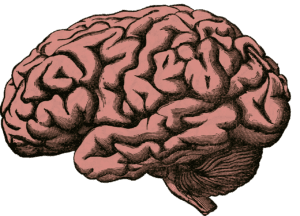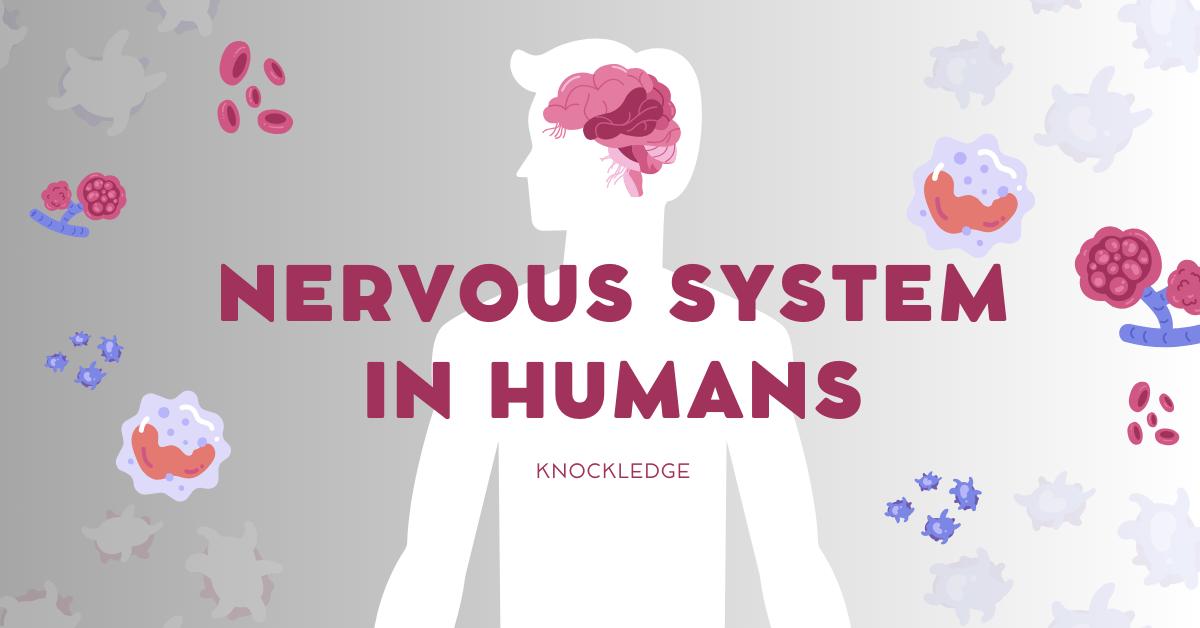Hello friends,
In this post, we are going to explore the “Nervous System in Humans”. This system is like the body’s communication network, controlling everything we do. It’s made up of the brain, spinal cord, and nerves, working together to send messages throughout our body. The Nervous System in Humans plays a crucial role in how we move, think, and feel. Let’s explore this intricate system and understand how it orchestrates the symphony of our daily activities.
What happens when you are in contact with something very hot?
You pull your hands back in order to prevent your skin burn.
What do you do when you hear something very loud?
You cover your ears for comfort.
What do you do when there is a bad smell in your environment?
You cover your nose in order to get away from those smells and relief your nose.
What do you do when there is a very luminous object in front of your eyes?
You close your eyes in order to prevent eye damage and pain in eyes.
Have you noticed in the above context that an organ that is afflicted (in trouble) at a particular time is automatically being relieved by your actions? Well, these actions that you do to relief yourself at a particular time are controlled by your brain; whereas these weird happenings (sudden changes in the environment: hot things, loud sounds & bad smells) are called stimuli (singular: stimulus). The organs that are involved in the process of stimuli are controlled by your nervous system.
Therefore, we can say that, many organs work together to respond to the stimuli and the nervous system controls these organs.
KEY NOTES
- An impulsive change in the environment of an organism that starts a reaction with the organism is the stimulus. For example – hearing loud sounds, sensing bad smells and being exposed to too hot or too cold things.
- The reaction of the organism to the stimuli is the response.
- Dealing with stimuli is all controlled by your brain.
- There are 11 organ systems in human body.
- External stimuli: the stimuli caused by external factors. E.g. other living things or non-living like water, heat, temperature change, dust and chemicals
- Internal stimuli: the stimuli originating inside the organism’s body. E.g. sensation of thirst, hunger and pain.
NERVE CELL OR NEURON
Neuron is the basic structural and functional unit of nervous system.
- It is the longest cell of human body
- Human brain has an estimate of about 100 billion neurons
- Messages are received and sent through neurons spread in the whole body
STRUCTURE OF A NEURON
1) Neuron: A specialized cell that helps in receiving messages from one part of your body and transferring them to other parts is a nerve cell or a neuron. It has three main parts → cell body, axon and dendrites.
2) Cyton (cell body/soma): is a cell body that contains the nucleus and is present in each neuron.
3) Dendrons & Dendrites: Dendrons are short fibres that originate in the cyton (cell body) and further divide into dendrites (smaller dendrons) forming a network of fibres. Dendrites are responsible to receive messages from other nerve cells, and pass them to another neuron.
4) Axon (longest Dendron): The axon is a single long fibre that originates from one side of the cyton. The axon is responsible to carry the messages received by the dendrons and dendrites from one neuron to another. The axon is covered with a sheath known as the myelin sheath.
5) Myelin sheath: it helps to protect the axon.
6) Schwann’s cells: another protective covering of the axon above the myelin sheath acts as a support.
7) Impulse: A chemical disturbance like an electrical signal that helps to transfer the messages along the neuron in the form of a wave is an impulse. In biology, a message is an impulse.
SYNAPSE
Neurons are not in direct contact with each other in order to transfer the messages. In this case, the synapse acts as a gap between the two neurons and helps in transfer of message. Synapse is the junction (or gap) between the two neurons, which transfers message from the axon ending of one neuron to the dendrites of another neuron.
NERVES
Many neurons join together to form nerve fibres and many nerve fibres join (end-to-end) to form a nerve.
TYPES OF NERVES (TYPE 1 → sensory, motor and mixed; TYPE 2 → cranial and spinal)
TYPE 1 (depending upon the direction in which they transfer the impulse)
- Sensory Nerves (contain only sensory fibres): they are the nerves that transfer the impulse (message) from the sense organs (body organs), as the name suggests, to the brain or spinal cord. E.g. Optic nerve: nerve connecting eye and brain, to transfer impulses from the eye to the brain, Auditory/Acoustic nerve: nerve connecting ear and brain, to transfer impulses from the ear to the brain.
- Motor Nerves (contain only motor fibres): they are the nerves that transfer the impulse (message) from the brain or spinal cord to other body parts (muscles and glands). E.g. nerves from the brain to the muscles of the eyeballs, to transfer impulses from the brain to the eye.
- Mixed/Association Nerves (contain both sensory and motor fibres): they perform the function of both sensory and motor nerves. They communicate between sensory and motor nerves. E.g. nerve that connects brain and tongue, where impulses transfer from the tongue to the brain, and from the brain to the tongue.
TYPE 2 (depending upon the place of origin of the nerves)
- Cranial (brain) Nerves: they are the nerves that originate in the brain and reach the organs in the head region (nearby). There are 12 pairs of cranial nerves, which are 24 in number. It consists of both sensory and motor nerves.
- Spinal (spinal cord) Nerves: they are the nerves that originate from the spinal cord and reach various body parts. There are 31 pairs of spinal nerves, which are 62 in number. It consists of both sensory and motor nerves.
NERVOUS SYSTEM IN HUMANS
Nervous system is the organ system that brings about coordination and integration of different body activities. E.g. coordination can be seen in this example: when we have food, our nose smells the food, our eyes help to locate the food, our hands bring the food to the mouth, the teeth and jaw muscles chew the food, saliva of mouth lubricates the food, and stomach digests the food.
Nervous system is a complex network of nerves that carry messages to and from the brain and spinal cord to various parts of the body. Here, the nerves carry out the task of a postman; bringing, sending and receiving messages one person to another person (from one body part to another part).
Nervous system → nerve/neuron, brain, spinal cord
THREE TYPES OF NERVOUS SYSTEMS
- Central nervous system (CNS) (contains brain and spinal cord)
- Peripheral nervous system (PNS) (contains cranial and spinal nerves only)
- Autonomic nervous system (ANS)
CENTRAL NERVOUS SYSTEM (CNS)
The central nervous system contains brain and spinal cord. It is the main control centre of our body functions, responsible for all the processing of information, and responsible for processing of every sensation and thought we experience in our life.
BRAIN

Definition: Just as the Principal of the school is the main, who controls the working of the school; the CPU of a computer is the main control centre for the computer; the same way in the nervous system of humans, brain is the main control centre.
Location: Brain is located in the cranium of the skull, the area in the forehead and above. Cranium is the skull, i.e. the bone inside the head.
Weight: Average weight of brain in an adult is about 1200 to 1400 g (that is 2% of body weight).
Function: It controls each activity we do, thinking, feelings, movement and senses. It is also the site of intelligence. If the brain does not work, the person is like a living dead.
Membranes: Brain is enclosed in three membranes for protection, called the meninges. The fluid between these meninges is cerebrospinal fluid (CSF). Importance of cerebrospinal fluid → it nourishes the brain and protects it from shocks by absorbing them.
Three divisions of brain: cerebrum, cerebellum, medulla oblongata
| PARAMETER | CEREBRUM | CEREBELLUM (little brain) | MEDULLA OBLONGATA |
| Location and Size | Bulk of the brain Uppermost and largest part | Small, egg-shaped lobe Located at the base of brain under cerebrum | Lowermost, located at the base of the skull |
| Structure | Highly convoluted (complex) with ridges and grooves, which increase the surface area to hold more neurons. Cerebrum is divided into → left and right cerebrum hemispheres with a deep furrow (trough) in between. | No convolutions, but has many furrows (trough) | Like a stem of brain, continues to become spinal cord in posterior (backward) region, although spinal cord is not the part of brain |
| Functions | 1. Centre of memory and intelligence. 2. It controls mental activities, thinking and reasoning. 3. It is responsible for sensation of pain, temperature, touch, sight, sound, taste and smell. | 1. It maintains balance of the body. 2. It coordinates movement of voluntary muscles. | 1. It controls heartbeat, breathing, coughing, sneezing and other involuntary movements (therefore, it is 24/7 active, even when we sleep) |
DID YOU KNOW?
- Human brain takes up only 2% of human body weight, but consumes approximate 20% oxygen of your body through blood.
- The left half of cerebrum (or left cerebrum hemisphere) controls right of your body, and the right cerebrum hemisphere controls the left of your body.
SPINAL CORD
Definition: Spinal cord is the continuation of the medulla oblongata at the base of the brain.
Location: It originates from the hole at the base of the skull that runs through the vertebral column.
Membranes: Just as the brain, spinal cord also has three meninges and cerebrospinal fluid (CSF) fluid between these meninges.
Cross-sectional view of spinal cord: If we cut the spinal cord in between, and then view the cross-section under microscope, we see that the cross-section has –
- Two symmetrical halves like an H-shaped structure or butterfly.
- The two halves are fused together to form a small canal in the centre, known as the central canal. The central canal also has cerebrospinal fluid.
- The H-shaped area contains the cyton part of the neurons, and is called the grey matter. The area outside the H-shaped region contains the axon part (nerve fibres) of the neurons, and is called the white matter. (NOTE: The situation in the cross-section of brain reverses. In brain, the inner portion is white matter, and outer portion is grey matter.)
Function:
- The spinal cord conducts the sensory impulses from skin and muscles to the brain, through sensory nerves.
- The spinal cord also conducts the motor responses from brain to the skin and muscles, through motor nerves.
PERIPHERAL NERVOUS SYSTEM (PNS)
- The system consists of two nerves: cranial and spinal nerves, coming up from the brain and spinal cord respectively.
- Function of these nerves: to link the central nervous system (brain and spinal cord) with many different parts of the body
- Fact: Sometimes these nerves are large and visible to the human eye.
- This system is responsible for voluntary tasks.
- It also consists of both sensory (afferent) and motor (efferent) nerves.
AUTONOMIC NERVOUS SYSTEM (ANS)
- The system consists of two networks: sympathetic and parasympathetic system.
- Function of the system: to control all the involuntary tasks of the body, e.g. heartbeat, muscle movement of stomach and intestines, etc. The medulla oblongata controls these involuntary tasks.

